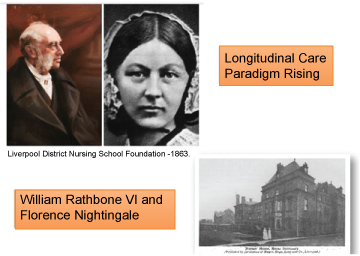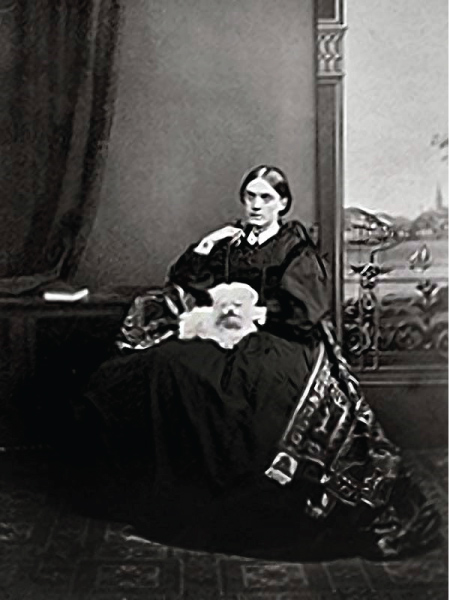The paradigm constitutes the development of what is called "normal science". On the other hand, one of the essential characteristics of medical and nursing practices in primary health care (PHC) is the longitudinal heed of human beings. William Rathbone VI was a merchant and businessman noted for his philanthropic work. In 1859 his appreciation for the services of a nurse, Mary Robinson, engaged to care for his dying wife, prompted him to campaign for a system of district nursing to enable the poor to benefit from similar care. Florence Nightingale advised him to establish a training home in Liverpool, which was completed by 1863. Regardless of who it may be, the longitudinal paradigm in today's primary care is of nursing and not medical source. The role of religious orders has been different from a historical point of view and it jumps the temporal limits of Late Modern Period of History.
(MESH) Science, History of nursing, History of medicine, Caregivers, Continuity of patient care
One of the essential characteristics of medical and nursing practices in primary health care (PHC) is the longitudinal heed of human beings [1]. A widely accepted hypothesis in Europe and the Western world is that the beginning of contemporary PHC took place at the Alma-Ata Conference, which is now 40-years-old [2,3]. However we think that the historical roots are further back. We follow in this hypothesis the works of powerful researchers in PHC such as Barbara Starfield [4], Denis Pereira Gray [5] and Trisha Greenhalgh [6,7].
By the year 1962, Thomas Kühn, an American physicist who felt early vocation to the history of science, published a book that has become a true best seller of the specialty. "The structure of Scientific Revolutions" [8]. It first appeared as a monograph of the International Encyclopedia of Unified Science [9] to be subsequently published as a book. In his work, Künh defined the paradigm concept as the first known in the history of science.
The paradigm, in this way, constitutes the development of what Kühn calls "normal science", and as such is manifested through the textbooks of a science or discipline, by presenting the theories accepted by the scientific communities of each discipline, explaining them and comparing them, showing them through experiments and observations. The paradigm defines the methods, the problems that a discipline or field of research must legitimately address, to be bequeathed to future generations of scientists. Although the paradigm concept has had naggings it cannot be doubted that it is an excellent analytical tool for the study of the development of a discipline. That's why we use it in this paper.
William Rathbone VI (1819-1902) was a merchant and businessman noted for his philanthropic and public work. He was an English Liberal politician who sat in the House of Commons at various times between 1868 and 1895. Rathbone spent some time with various companies in Liverpool and London and in 1842 became a partner in the family company Rathbone Brothers and Co., general merchants of Liverpool. He is said to have regarded wealth and business success chiefly as a means to the achievement of public and philanthropic work.
In 1859 his appreciation for the services of a nurse, Mary Robinson, engaged to care for his dying wife, Lucretia, his first wife, prompted him to campaign for a system of district nursing to enable the poor to benefit from similar care; his involvement of Florence Nightingale (1820-1910) led to a close friendship [10]. She advised him to establish a training home in Liverpool, which was completed by 1863, because Nightingale's epidemiological investigations showed the need of reforms and an educated nurse who could provide better healthcare [11]. They subsequently wrote regularly to each other, sharing ideas and experiences, and mutual encouragement [12]. Florence Nightingale had a profound impact on the early development of district nursing and also the foundation of the Queen's Institute in 1887 [13] (Figure 1).
 Figure 1: In 1863 a School of District Nursing was founded in Liverpool thanks to the collaboration and friendship between Rathbone and Nightingale. View Figure 1
Figure 1: In 1863 a School of District Nursing was founded in Liverpool thanks to the collaboration and friendship between Rathbone and Nightingale. View Figure 1
In 1863, the Liverpool Training School and Home for Nurses was established, from which basis a district nursing system was implemented in Liverpool through the 1860s and spread throughout the country [14]. William Rathbone VI's involvement with this scheme also made him aware of the poor state of the workhouse hospitals, and he did much to assist in the reform of the nursing in workhouses [15].
He married firstly Lucretia Wainwright Gair (1823-1859). They had five children, but Lucretia died shortly after the birth of the fifth. She was lovely cared by Mary Robinson. Rathbone re-married on 6 February 1862 to Esther Emily Acheson Lyle (1832-1918). They had six children, including the campaigner and politician, Eleanor Rathbone and Emily Evelyn (Evie) (1865-1954) who married with her cousin Hugh Reynolds Rathbone. Emily Rathbone actively supported her husband's work in the establishment of District Nursing in Liverpool, and initiating a schools' nursing service in the city in 1895 (Figure 2).
 Figure 2: Emily Rathbone (Evie) (1865-1954). Lady Superintendent of District Nurses. View Figure 2
Figure 2: Emily Rathbone (Evie) (1865-1954). Lady Superintendent of District Nurses. View Figure 2
One of the researchers who first preferred the term "longitudinality" to the continuity of care was Barbara Starfield in her classic volume on primary care [16]. It had been showed before a greater satisfaction of patients with the continuity of health care [17]. As well, longitudinal care is inversely associated with mortality rates [18]. Nevertheless, the value of continuity of care has been strengthened by discontinuity research [19,20]. For all these reasons we think the concept or paradigm of "longitudinal care" is angular in contemporary health thought.
Although they have existed earlier historical figures such as Saint John God (1495-1550) [21] and Miguel Manara (1627-1679) [22] that upgraded the concept of health care in time, we think that the "contemporary nature" of longitudinal caregiver was born in Liverpool with the creation of the School of Community Nurses. We consider that the one who perceived first the shift of informal to formal caregiver was William Rathbone VI after the experience of the loss of his first wife and the evaluation of Mary Robinson's tasks. She was perhaps the first modern formal caregiver. The role of deaconesses [23,24] is something similar but different because they have a strong religious base [25]. The role of religious orders has been different from a historical point of view and it jumps the temporal limits of Late Modern Period of History. The longitudinal care necessitated by social issues and not spiritual or religious needs or motivations.
It is difficult to discuss the history of district nursing without a mention of the notorious fictional characters of Sarah Gamp and her colleague Betsy Prig portrayed by Charles Dickens [26], although sometimes he did it in too favorable terms [27]. In other Anglo-Saxon countries like Australia, district nursing was born somewhat later [28].
Regardless of who it may be, the longitudinal paradigm in today's PHC is of nursing and not medical origin. History should not only be a research [29] and reflective practice for nursing [30,31], it should also be for family medicine in this case [32,33]. The aim of contemporary history is to conceptualise, contextualise and historicise some aspect of the recent past or to provide a historical understanding of current trends or developments. The increase in the velocity of history means, among other things, that the ‘present' becomes the ‘past' more swiftly than ever before, especially in the hyper-connected society we live.
In summary, we defend in this article the hypothesis that the concept of longitudinality in contemporary primary care was beard during the late period of modern history (1863) in Liverpool. Its rational origin is a nursing enterprise. Over time, the longitudinal paradigm of care has become consubstantial with the specialties of Family Medicine [34] and Community Nursing [35].